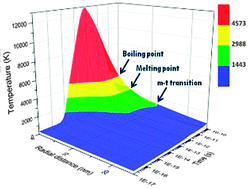Amorphization of nanocrystalline monoclinic ZrO2 by swift heavy ion irradiation
Abstract
Bulk ZrO2 polymorphs generally have an extremely high amorphization tolerance upon low energy ion and swift heavy ion irradiation in which ballistic interaction and ionization radiation dominate the ion–solid interaction, respectively. However, under very high-energy irradiation by 1.33 GeV U-238, nanocrystalline (40–50 nm) monoclinic ZrO2 can be amorphized. A computational simulation based on a thermal spike model reveals that the strong ionizing radiation from swift heavy ions with a very high electronic energy loss of 52.2 keV nm−1 can induce transient zones with temperatures well above the ZrO2 melting point. The extreme electronic energy loss, coupled with the high energy state of the nanostructured materials and a high thermal confinement due to the less effective heat transport within the transient hot zone, may eventually be responsible for the ionizing radiation-induced amorphization without transforming to the tetragonal polymorph. The amorphization of nanocrystalline


 Please wait while we load your content...
Please wait while we load your content...